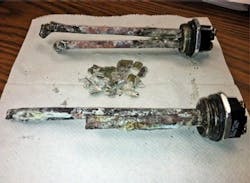Water Conditioning: Water Conditioning Goes to Court
About the author: Matt Taylor is managing partner for Fluid Dynamics USA. Taylor can be reached at [email protected] or 844.966.7225.
According to the U.S. Geological Survey, more than 85% of the U.S. has hard water. In plumbing, hard water leaves calcite deposits, commonly known as scale, that restrict water flow by occluding pipe. In water heaters, calcite coats heating elements, causing them to overheat and eventually fail. Standard approaches to calcite mitigation rely on chemicals (salts) or ultra-fine membrane filtration.
The General Services Administration (GSA), the U.S. agency responsible for building and managing government facilities, commissioned Oak Ridge National Laboratory (ORNL) to assess the effectiveness of a catalytic insert that alters the chemistry of hard water to prevent calcite buildup. The project was conducted through GSA’s Green Proving Ground (GPG) program, which represents an innovative response to Executive Order 13514, also known as “Planning for Federal Sustainability in the Next Decade.”
To meet target sustainability goals and enable the realization of net-zero energy buildings, federal agencies must develop effective ways of reducing energy use. GPG leverages GSA’s real estate portfolio to evaluate innovative sustainable building technologies and provide recommendations on their deployment. By devoting research to technologies in the pre- or early-commercial stages of development, GPG facilitates and accelerates the transition between bench-scale technology and commercial viability.
Working with the Department of Energy’s national laboratories, GPG evaluates technologies in a real-world context. Project reports are developed through the combined efforts of GPG and the national laboratories to provide credible, detailed information about product performance that helps determine the technology’s success in the marketplace.
The hard water study focused on a scale prevention technology that is new to the U.S. but has been used around the world for more than 40 years. Developed by Fluid Dynamics, the proprietary catalytic technology is salt-free and uses no chemicals or power to resolve the problem of calcium deposits due to hard water.
The catalytic technology is integrated into the line carrying the water, which flows over a proprietary metal alloy that causes calcium and bicarbonate to bond together to form calcium carbonate in its aragonite state. The aragonite remains suspended in the water instead of bonding to surfaces like calcite, another form of calcium carbonate.
The GSA study documented the scientific and economic effectiveness of this scale prevention approach. It focused on hard water in heating systems, where calcium deposits can cause serious problems ranging from increased energy usage to outright system failure, but the technology can be effective in any application where scaling is an issue.
The field study was conducted in 2013 and 2014, with researchers assessing the technology at the Frank E. Moss Federal Courthouse in Salt Lake City. They found that catalyst-based non-chemical water treatment (NCWT) reduced calcite buildup and had immediate payback when compared with a salt-based system. The study also found that the technology eliminated prior scaling over a period of time.
Technology & Test Description
The NCWT technology assessed in this measurement and verification process consists of a length of pipe containing a single fixed helical insert. The insert is made from a proprietary catalytic alloy and is installed directly into the water delivery pipe. As water flows over the metallic alloy, calcium and bicarbonate form flushable calcium carbonate crystals in the form of the inert mineral aragonite rather than calcite.
The technology is installed by removing a section of the cold water and recirculating line and replacing it with the pipe containing the helical insert. Unit sizing ranges from 1/4 to 16 in. and is determined by the flow rate of the water being treated. Once installed, the system operates as a stand-alone device over its 15-year life span.
ORNL researchers tested the catalyst-based technology in an electric domestic water heater. The water heater provided an ideal test bed because it was located in an area of high groundwater hardness and had no installed calcite control technology. Over the course of 18 months, ORNL conducted pre- and post-installation assessments of calcite formation on the water system’s heating elements and documented energy use, incidence of element failure, and labor and material costs. Researchers also conducted a preliminary economic analysis of installed cost and potential savings on the courthouse’s cooling tower.
Key Findings
Before installation of the catalytic-based technology, and in the absence of any kind of water treatment, commercial-grade heating elements at the Moss Federal Courthouse had such significant calcite buildup that they overheated and failed after only two months of operation. After installation, elements had little visible calcite buildup, even after 18 months of operation.
The system requires minimal operations and maintenance. Little training was needed for site personnel, as there are no moving parts or chemicals added. In systems without a drain, aragonite can form soft sediment in the bottom of the tank, which should be removed either manually or with a wet/dry vacuum every 18 to 24 months.
Researchers determined that the catalyst-based NCWT technology is ideal for facilities with calcification issues. This technology may be particularly beneficial in remote locations, where lack of access to power, chemicals and labor can make conventional water softening impractical and expensive.
The catalyst-based system had minimal operational costs beyond the initial installed cost of $1,692. At the Moss Federal Courthouse, simple payback was less than two years, when compared with the cost of replacing failed heating elements.
Conclusions
At the Moss Federal Courthouse, the catalyst-based non-chemical water treatment prevented calcite buildup with minimal operations and maintenance costs. The technology can be implemented for any heating system with calcification issues, including hydronic heating systems and boilers, condensing boilers, and gas and electric water heaters.
Download: Here
